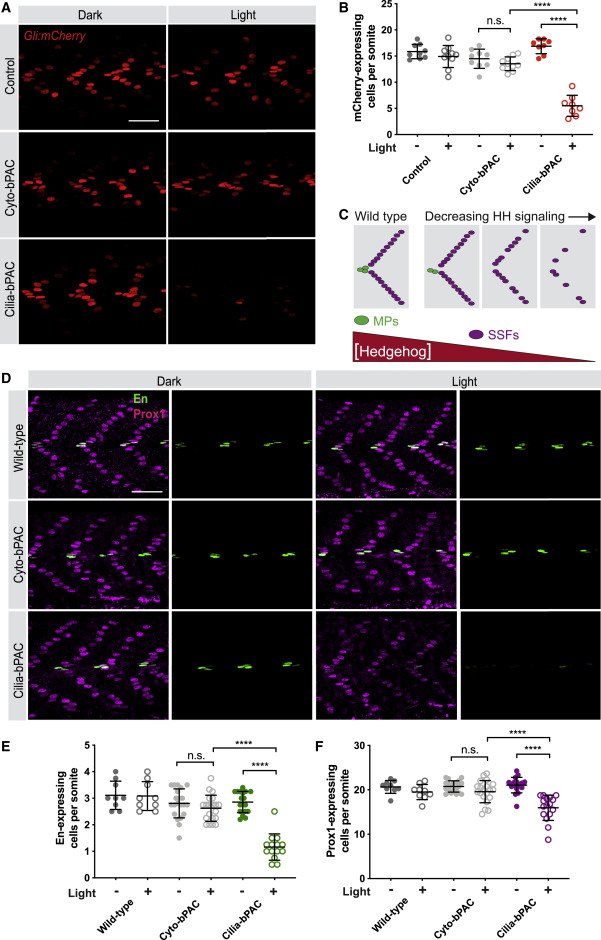Fig. 2 (A) Immunofluorescence imaging of wild-type and transgenic NIH/3T3 cells stably expressing GFP-tagged Cyto-bPAC or Cilia-bPAC under the control of a minimal δ-crystallin promoter stained for GFP-tagged bPAC (green), cilia (TUBAC, red), basal bodies (γTUB, grayscale) and nuclei (blue). Arrowheads indicate cilia depicted in insets. Insets display overlay (top), cilia and basal bodies alone (middle), and GFP-tagged bPAC alone (bottom). Scale bars, 10 μm and 2 μm (inset). (B) Immunoblot of wild-type and transgenic NIH/3T3 cells stably expressing GFP-tagged Cyto-bPAC and Cilia-bPAC under the control of the EF1α promoter. Whole-cell protein lysates were immunoblotted with antibodies to GFP and GAPDH loading control. (C) Quantification of cAMP in wild-type or transgenic cells expressing Cyto-bPAC or Cilia-bPAC under the control of a minimal δ-crystallin promoter by ELISA. Cells were stimulated with pulsed 0.14 mW/cm2 470 nm blue light or kept in the dark in the presence of 100 μM IBMX for 30 min. cAMP concentration was determined by ELISA and normalized to total protein content. n = 4 biological replicates. Significance was determined via two-way ANOVA followed by Tukey’s multiple comparison test. (D) Quantitation of Ciliary Pink Flamindo fluorescence in Cyto-bPAC-expressing (red) or Cilia-bPAC-expressing (blue) cells either with (solid circles) or without blue light (open circles). Cells were stimulated with 100-ms pulses of 52.7 mW/cm2 blue light every 3 s for 1 min. At the end of that minute, 100 μM forskolin was added. We calculated the ratio of Pink Flamindo to mIFP fluorescence normalized to the ratio at t = 0. Each trace represents n > 12 cells from three independent experiments. The maximum Ciliary Pink Flamindo fluorescence on blue light stimulation is also shown. Significance was assessed using two-way ANOVA followed by Tukey’s multiple comparison test. (E) qRT-PCR measurement of Gli1 expression by wild-type, Cyto-bPAC-expressing cells, or Cilia-bPAC-expressing cells stimulated for 4 h with vehicle (DMSO), 200 nM SAG, or 200 nM SAG with pulsed 0.14 mW/cm2 470 nm blue light. n = 3 biological replicates. Significance was assessed using one-way ANOVA followed by Tukey’s multiple comparison test. (F) Ratios of Gli1 expression in wild-type and Cyto-bPAC-expressing or Cilia-bPAC-expressing cells treated with 200 nM SAG and blue light to Gli1 expression treated with 200 nM SAG alone. Significance was assessed using one-way ANOVA followed by Tukey’s multiple comparison test. (G) Immunoblots of GLI3 and GAPDH of whole-cell lysates from wild-type, Cyto-bPAC-expressing, or Cilia-bPAC-expressing cells stimulated as in (E). (H) Quantification of GLI3 repressor (GLI3R) normalized to GAPDH (loading control). n = 3 biological replicates. Significance was assessed using one-way ANOVA followed by Tukey's multiple comparison test. For all panels, p values are indicated as follows: ∗p < 0.05, ∗∗p < 0.01, ∗∗∗p < 0.001 and ∗∗∗∗p < 0.0001. Data are represented as means ± SD.
Reprinted from Cell, 184(11), Truong, M.E., Bilekova, S., Choksi, S.P., Li, W., Bugaj, L.J., Xu, K., Reiter, J.F., Vertebrate cells differentially interpret ciliary and extraciliary cAMP, 2911-2926.e18, Copyright (2021) with permission from Elsevier. Full text @ Cell

